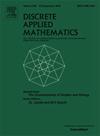满足有向路径划分猜想的一些有向图类
IF 1
3区 数学
Q3 MATHEMATICS, APPLIED
引用次数: 0
摘要
设λ(D)表示有向图D中最长路径的阶。对于不相交的a,B≥V(D),若a∪B=V(D),则(a,B)是D的一个分区。有向路径分区猜想(DPPC)表明,对于每一个有向图D和每一个整数q,具有q<;λ(D),则D存在一个分区(a,B),使得λ(D[a])≤q且λ(D[B])≤λ(D)−q。Arroyo和Galeana-Sánchez(2013)证明了每一个强3-拟传递有向图都满足DPPC。他们还表明DPPC适用于有向图满足DPPC的无环有向图上的组合。本文证明了非强3-拟传递有向图和强4-传递有向图也满足DPPC。此外,我们还证明了DPPC对于满足DPPC和某些其他条件的单环有向图上的组合是成立的。此外,通过应用不同的论证,我们证明了具有任意有向图的循环上的组合符合DPPC。本文章由计算机程序翻译,如有差异,请以英文原文为准。
Some digraph classes that meet the directed path partition conjecture
Let denote the order of a longest path in a digraph . For disjoint , if , we say that is a partition of . The Directed Path Partition Conjecture (DPPC) states that for every digraph and every integer with , there is a partition of such that and .
Arroyo and Galeana-Sánchez (2013) proved that every strong 3-quasi-transitive digraph satisfies the DPPC. They also showed that the DPPC holds for compositions over an acyclic digraph with digraphs that meet the DPPC. In the paper, we show that non-strong 3-quasi-transitive digraphs and strong 4-transitive digraphs also satisfy the DPPC. Additionally, we show that the DPPC holds for the compositions over a unicyclic digraph with digraphs that satisfy the DPPC and certain other conditions. Furthermore, by applying different arguments, we show that the compositions over a cycle with arbitrary digraphs meets the DPPC.
求助全文
通过发布文献求助,成功后即可免费获取论文全文。
去求助
来源期刊

Discrete Applied Mathematics
数学-应用数学
CiteScore
2.30
自引率
9.10%
发文量
422
审稿时长
4.5 months
期刊介绍:
The aim of Discrete Applied Mathematics is to bring together research papers in different areas of algorithmic and applicable discrete mathematics as well as applications of combinatorial mathematics to informatics and various areas of science and technology. Contributions presented to the journal can be research papers, short notes, surveys, and possibly research problems. The "Communications" section will be devoted to the fastest possible publication of recent research results that are checked and recommended for publication by a member of the Editorial Board. The journal will also publish a limited number of book announcements as well as proceedings of conferences. These proceedings will be fully refereed and adhere to the normal standards of the journal.
Potential authors are advised to view the journal and the open calls-for-papers of special issues before submitting their manuscripts. Only high-quality, original work that is within the scope of the journal or the targeted special issue will be considered.
 求助内容:
求助内容: 应助结果提醒方式:
应助结果提醒方式:


